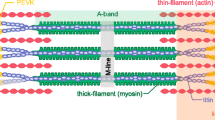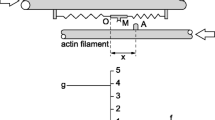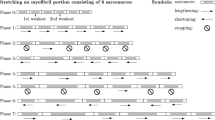Abstract
We address the well-known limitation of the Huxley and Simmons 1971 (HS) model. It is the statement that at physiological value of stiffness in the actomyosin complex, the distribution of the myosin motors becomes microscopically uniform (all the motors are either in pre- or post-power stroke conformation) after an infinitesimal displacement from the stall (isometric contractions) conditions. Such uniform behavior at the fiber level would generate a negative slope in the \(T_2-\delta \) relationship (in the nomenclature of the HS paper), not observed experimentally. This negative slope means inhomogeneity of the macroscopic sarcomere configuration, which is also not observed. To address this controversial prediction of the HS theory, we explore the possibility that the slope of the \(T_2-\delta \) curve is, in fact, positive due to an interaction between neighboring cross-bridges. We show that such interaction can potentially destabilize the uniform configurations (all pre or all post) by making the non-uniform configurations energetically preferable. We argue that, despite the presence of other factors, which can in principle also ensure the microscopic inhomogeneity of cross-bridge configurations, the implied interaction is an important player in muscle mechanics.




















Similar content being viewed by others
Notes
While it would have been more realistic to assume that this ratio is around 70-30 [71], we have chosen to present our results only in the most simple setting that can be easily corrected by the appropriate adjustment of the parameter \(v_0\).
References
M. Caruel, L. Truskinovsky, Physics of muscle contraction. Rep. Prog. Phys. 81(3), 036602 (2018)
T.L. Hill, Theoretical formalism for the sliding filament model of contraction of striated muscle part i. Prog. Biophys. Mole. Biol. 28, 267–340 (1974)
A.F. Huxley, R.M. Simmons, Proposed mechanism of force generation in striated muscle. Nature 233(5321), 533–538 (1971)
R.J. Podolsky, Kinetics of muscular contraction?: the approach to the steady state. Nature 188, 666–668 (1960)
G. Piazzesi, M. Reconditi, M. Linari, L. Lucii, Y.-B. Sun, T. Narayanan, P. Boesecke, V. Lombardi, M. Irving, Mechanism of force generation by myosin heads in skeletal muscle. Nature 415(6872), 659–662 (2002)
G. Piazzesi, M. Reconditi, M. Linari, L. Lucii, P. Bianco, E. Brunello, V. Decostre, A. Stewart, D. Gore, T. Irving, M. Irving, V. Lombardi, Skeletal muscle performance determined by modulation of number of myosin motors rather than motor force or stroke size. Cell 131(4), 784–795 (2007)
M. Irving, V. Lombardi, G. Piazzesi, M.A. Ferenczi, Myosin head movements are synchronous with the elementary force-generating process in muscle. Nature 357(6374), 156–158 (1992)
R. Sheshka, L. Truskinovsky, Power-Stroke-Driven Muscle Contraction (Springer, Cham, 2020), pp. 117–207
M. Caruel, J.-M. Allain, L. Truskinovsky, Mechanics of collective unfolding. J. Mech. Phys. Solids 76, 237–259 (2015)
M. Caruel, L. Truskinovsky, Statistical mechanics of the huxley-simmons model. Phys. Rev. E 93, 062407 (2016)
L. Marcucci, L. Truskinovsky, Mechanics of the power stroke in myosin ii. Phys. Rev. E 81, 051915 (2010)
L. Marcucci, L. Truskinovsky, Muscle contraction: a mechanical perspective. Eur. Phys. J. E. 32(4), 411–418 (2010)
E. Brunello, M. Caremani, L. Melli, M. Linari, M. Fernandez-Martinez, T. Narayanan, M. Irving, G. Piazzesi, V. Lombardi, M. Reconditi, The contributions of filaments and cross-bridges to sarcomere compliance in skeletal muscle. J. Physiol. 592(17), 3881–3899 (2014)
M. Linari, I. Dobbie, M. Reconditi, N. Koubassova, M. Irving, G. Piazzesi, V. Lombardi, The stiffness of skeletal muscle in isometric contraction and rigor: the fraction of myosin heads bound to actin. Biophys. J. 74(5), 2459–2473 (1998)
M. Caruel, J.-M. Allain, L. Truskinovsky, Muscle as a metamaterial operating near a critical point. Phys. Rev. Lett. 110(24), 248103 (2013)
A.F. Huxley, S. Tideswell, Filament compliance and tension transients in muscle. J. Muscle Res. Cell Motil. 17(4), 507–511 (1996)
A. Vilfan, T. Duke, Instabilities in the transient response of muscle. Biophys. J. 85(2), 818–827 (2003)
H. Borja da Rocha, Collective Effects in Muscle Contraction and Cellular Adhesion (Université Paris-Saclay, Theses Sept., 2018)
E. Brunello, M. Reconditi, R. Elangovan, M. Linari, Y.B. Sun, T. Narayanan, P. Panine, G. Piazzesi, M. Irving, V. Lombardi, Skeletal muscle resists stretch by rapid binding of the second motor domain of myosin to actin. Proc. Natl. Acad. Sci. USA 104(50), 20114–20119 (2007)
L.E. Ford, A.F. Huxley, R.M. Simmons, The relation between stiffness and filament overlap in stimulated frog muscle fibres. J. Physiol. 311, 219–249 (1981)
A.F. Huxley, Mechanics and models of the myosin motor. Philos. Trans. Royal Soc. B: Biol. Sci. 355(1396), 433–440 (2000)
G. Puglisi, L. Truskinovsky, Mechanics of a discrete chain with bi-stable elements. J. Mech. Phys. Solids 48(1), 1–27 (2000)
D.E. Rassier, I. Pavlov, Contractile Characteristics of Sarcomeres Arranged in Series or Mechanically Isolated from Myofibrils (Springer, New York, 2010), pp. 123–140
R.T. Tregear, M.C. Reedy, Y.E. Goldman, K.A. Taylor, H. Winkler, C. Franzini-Armstrong, H. Sasaki, C. Lucaveche, M.K. Reedy, Cross-bridge number, position, and angle in target zones of cryofixed isometrically active insect flight muscle. Biophys. J. 86(5), 3009–3019 (2004)
S. Wu, J. Liu, M.C. Reedy, R.J. Perz-Edwards, R.T. Tregear, H. Winkler, C. Franzini-Armstrong, H. Sasaki, C. Lucaveche, Y.E. Goldman, M.K. Reedy, K.A. Taylor, Structural changes in isometrically contracting insect flight muscle trapped following a mechanical perturbation. PloS one 7(6), e39422–e39422 (2012)
M. Reconditi, Recent improvements in small angle x-ray diffraction for the study of muscle physiology. Rep. Prog. Phys. 69(10), 2709–2759 (2006)
R.T. Tregear, R.J. Edwards, T.C. Irving, K.J. Poole, M.C. Reedy, H. Schmitz, E. Towns-Andrews, M.K. Reedy, X-ray diffraction indicates that active cross-bridges bind to actin target zones in insect flight muscle. Biophys. J. 74(3), 1439–1451 (1998)
M. Caremani, L. Melli, M. Dolfi, V. Lombardi, M. Linari, Force and number of myosin motors during muscle shortening and the coupling with the release of the atp hydrolysis products. J. Physiol. 593(15), 3313–3332 (2015)
G. Piazzesi, V. Lombardi, A cross-bridge model that is able to explain mechanical and energetic properties of shortening muscle. Biophys. J. 68(5), 1966–1979 (1995)
D.A. Smith, M.A. Geeves, J. Sleep, S.M. Mijailovich, Towards a unified theory of muscle contraction i: Foundations. Ann. Biomed. Eng. 36(10), 1624–1640 (2008)
D.A. Smith, S.M. Mijailovich, Toward a unified theory of muscle contraction ii Predictions with the mean-field approximation. Ann. Biomed. Eng. 36(8), 1353 (2008)
H. Borja da Rocha, L. Truskinovsky, Functionality of disorder in muscle mechanics. Phys. Rev. Lett. 122, 088103 (2019)
R. Sheshka, P. Recho, L. Truskinovsky, Rigidity generation by nonthermal fluctuations. Phys. Rev. E 93, 052604 (2016)
J.C. Bonner, J.F. Nagle, Phase behavior of models with competing interactions. J. Appl. Phys. 42(4), 1280–1282 (1971)
A. Campa, G. Gori, V. Hovhannisyan, S. Ruffo, A. Trombettoni, Ising chains with competing interactions in the presence of long-range couplings. J. Phys. A: Math. Theor. 52(34), 344002 (2019)
M. Kardar, Crossover to equivalent-neighbor multicritical behavior in arbitrary dimensions. Phys. Rev. B 28, 244–246 (1983)
J.F. Nagle, Ising chain with competing interactions. Phys. Rev. A 2, 2124–2128 (1970)
P.A. Rikvold, G. Brown, S. Miyashita, C. Omand, M. Nishino, Equilibrium, metastability, and hysteresis in a model spin-crossover material with nearest-neighbor antiferromagnetic-like and long-range ferromagnetic-like interactions. Phys. Rev. B 93, 064109 (2016)
J. Barré, D. Mukamel, S. Ruffo, Inequivalence of ensembles in a system with long-range interactions. Phys. Rev. Lett. 87, 030601 (2001)
J. Barré, D. Mukamel, S. Ruffo, Ensemble Inequivalence in Mean-Field Models of Magnetism (Springer, Berlin, 2002), pp. 45–67
F. Bouchet, S. Gupta, and D. Mukamel. Thermodynamics and dynamics of systems with long-range interactions. Physica A: Statistical Mechanics and its Applications, 389(20):4389 – 4405, 2010. Proceedings of the 12th International Summer School on Fundamental Problems in Statistical Physics
L. Marcucci, T. Washio, T. Yanagida, Including thermal fluctuations in actomyosin stable states increases the predicted force per motor and macroscopic efficiency in muscle modelling. PLoS Comput. Biol. 12(9), 1–20 (2016)
M. Ostilli, F. Mukhamedov, 1D Three-state mean-field potts model with first- and second-order phase transitions. Physica A 555, 124415 (2020)
J. Yeomans, Statistical Mechanics of Phase Transitions (Clarendon Press, 1992)
J.M. Squire, D.M. Paul, E.P. Morris, Myosin and Actin Filaments in Muscle: Structures and Interactions (Springer, Cham, 2017), pp. 319–371
M. Kaya, Y. Tani, T. Washio, T. Hisada, H. Higuchi, Coordinated force generation of skeletal myosins in myofilaments through motor coupling. Nat. Commun. 8, 16036 (2017)
M.V. Razumova, A.E. Bukatina, K.B. Campbell, Different myofilament nearest-neighbor interactions have distinctive effects on contractile behavior. Biophys. J. 78(6), 3120–3137 (2000)
J.M. Squire, Muscle myosin filaments: cores, crowns and couplings. Biophys. Rev. 1(3), 149 (2009)
A. Månsson, D. Rassier, G. Tsiavaliaris, Poorly understood aspects of striated muscle contraction. BioMed. Res. Int. 2015, 245154 (2015)
B.C.W. Tanner, T.L. Daniel, M. Regnier, Sarcomere lattice geometry influences cooperative myosin binding in muscle. PLOS Comput. Biol. 3(7), 1–17 (2007)
K. Oshima, Y. Takezawa, Y. Sugimoto, T. Kobayashi, T.C. Irving, K. Wakabayashi, Axial dispositions and conformations of myosin crossbridges along thick filaments in relaxed and contracting states of vertebrate striated muscles by x-ray fiber diffraction. J. Mol. Biol. 367(1), 275–301 (2007)
W.O. Hancock, L.L. Huntsman, A.M. Gordon, Models of calcium activation account for differences between skeletal and cardiac force redevelopment kinetics. J. Muscle Res. Cell Motil. 18(6), 671–681 (1997)
T.L. Hill, E. Eisenberg, L. Greene, Theoretical model for the cooperative equilibrium binding of myosin subfragment 1 to the actin-troponin-tropomyosin complex. Proc. Natl. Acad. Sci. 77(6), 3186–3190 (1980)
S.M. Mijailovich, J.J. Fredberg, J.P. Butler, On the theory of muscle contraction: filament extensibility and the development of isometric force and stiffness. Biophys. J. 71(3), 1475–1484 (1996)
J.J. Rice, G. Stolovitzky, Y. Tu, P.P. de Tombe, Ising model of cardiac thin filament activation with nearest-neighbor cooperative interactions. Biophys. J. 84(2), 897–909 (2003)
K.S. Campbell, Filament compliance effects can explain tension overshoots during force development. Biophys. J. 91(11), 4102–4109 (2006)
P.B. Chase, J.M. Macpherson, T.L. Daniel, A spatially explicit nanomechanical model of the half-sarcomere: myofilament compliance affects Ca2+-activation. Ann. Biomed. Eng. 32(11), 1559–1568 (2004)
T.L. Daniel, A.C. Trimble, P.B. Chase, Compliant realignment of binding sites in muscle: transient behavior and mechanical tuning. Biophys. J. 74(4), 1611–1621 (1998)
J.D. Powers, P. Bianco, I. Pertici, M. Reconditi, V. Lombardi, G. Piazzesi, Contracting striated muscle has a dynamic i-band spring with an undamped stiffness 100 times larger than the passive stiffness. J. Physiol. 598(2), 331–345 (2020)
P.-G. de Gennes, Maximum pull out force on dna hybrids. Comptes Rendus de l’Académie des Sci. - Series IV - Phys. 2(10), 1505–1508 (2001)
X. Ren, L. Truskinovsky, Finite scale microstructures in nonlocal elasticity. J. Elast. Phys. Sci. Solids 59(1), 319–355 (2000)
P.M. Chaikin, T.C. Lubensky, T.A. Witten, Principles of Condensed Matter Physics, 10th edn. (Cambridge University Press, Cambridge, 1995)
K. Hirose, T. Wakabayashi, Structural change of crossbridges of rabbit skeletal muscle during isometric contraction. J. Muscle Res. Cell Motil. 14(4), 432–445 (1993)
K. Midde, R. Luchowski, H. Das, J. Fedorick, V. Dumka, I. Gryczynski, Z. Gryczynski, J. Borejdo, Evidence for pre- and post-power stroke of cross-bridges of contracting skeletal myofibrils. Biophys. J. 100(4), 1024–1033 (2011)
M. Reedy, Visualizing myosin’s power stroke in muscle contraction. J. Cell Sci. 113(20), 3551–3562 (2000)
D.D. Thomas, S. Ramachandran, O. Roopnarine, D.W. Hayden, E.M. Ostap, The mechanism of force generation in myosin: a disorder-to-order transition, coupled to internal Structural changes. Biophys. J. 68(4 Suppl), 135S–141S (1995)
M. Reconditi, M. Caremani, F. Pinzauti, J.D. Powers, T. Narayanan, G.J.M. Stienen, M. Linari, V. Lombardi, G. Piazzesi, Myosin filament activation in the heart is tuned to the mechanical task. Proc. Natl. Acad. Sci. 114(12), 3240–3245 (2017)
G. Piazzesi, F. Francini, M. Linari, V. Lombardi, Tension transients during steady lengthening of tetanized muscle fibres of the frog. J. Physiol 445, 659–711 (1992)
M. Reconditi, M. Linari, L. Lucii, A. Stewart, Y.-B. Sun, P. Boesecke, T. Narayanan, R.F. Fischetti, T. Irving, G. Piazzesi, M. Irving, V. Lombardi, The myosin motor in muscle generates a smaller and slower working stroke at higher load. Nature 428(6982), 578–581 (2004)
N. Goldenfeld, Lectures on Phase Transitions and the Renormalization Group (Frontiers in physics. Addison-Wesley, Advanced Book Program, 1992)
M. Irving, G. Piazzesi, L. Lucii, Y.-B. Sun, J.J. Harford, I.M. Dobbie, M.A. Ferenczi, M. Reconditi, V. Lombardi, Conformation of the myosin motor during force generation in skeletal muscle. Nat. Struct. Biol. 7(6), 482–485 (2000)
K. Christensen, N.R. Moloney, Complexity and Criticality, 1st edn. (World Scientific Publishing Company, Singapore, 2005)
R. Pathria, P. Beale, Statistical Mechanics (Elsevier, Hoboken, 1996)
A. Campa, T. Dauxois, S. Ruffo, Statistical mechanics and dynamics of solvable models with long-range interactions. Phys. Rep. 480(3–6), 57–159 (2009)
M. Linari, E. Brunello, M. Reconditi, L. Fusi, M. Caremani, T. Narayanan, G. Piazzesi, V. Lombardi, M. Irving, Force generation by skeletal muscle is controlled by mechanosensing in myosin filaments. Nature 528(7581), 276–279 (2015)
K.A. Taylor, H. Schmitz, M.C. Reedy, Y.E. Goldman, C. Franzini-Armstrong, H. Sasaki, R.T. Tregear, K. Poole, C. Lucaveche, R.J. Edwards, L.F. Chen, H. Winkler, M.K. Reedy, Tomographic 3D reconstruction of quick-frozen, \(Ca>sup<2+>/sup>\)-activated contracting insect flight muscle. Cell 99(4), 421–431 (1999)
J. Crangle, Solid,State Magnetism (Springer, Berlin, 2012)
A.A. Zvyagin, G.A. Skorobagat’ko, On the mean-field theory of a two-sublattice antiferromagnet. Low Temp. Phys. 32(7), 644–649 (2006)
R. Agra, F. van Wijland, E. Trizac, On the free energy within the mean-field approximation. Euro. J. Phys. 27(2), 407–412 (2006)
Acknowledgements
The authors thank Marco Linari and Matthieu Caruel for helpful discussion. H.B.R. was supported by a PhD fellowship from Ecole Polytechnique; L. T. was supported by the grant ANR-10-IDEX-0001-02 PSL.
Author information
Authors and Affiliations
Corresponding author
Rights and permissions
About this article
Cite this article
Rocha, H.B.d., Truskinovsky, L. A plausible mechanism of muscle stabilization in stall conditions. Eur. Phys. J. Plus 136, 683 (2021). https://doi.org/10.1140/epjp/s13360-021-01646-y
Received:
Accepted:
Published:
DOI: https://doi.org/10.1140/epjp/s13360-021-01646-y




